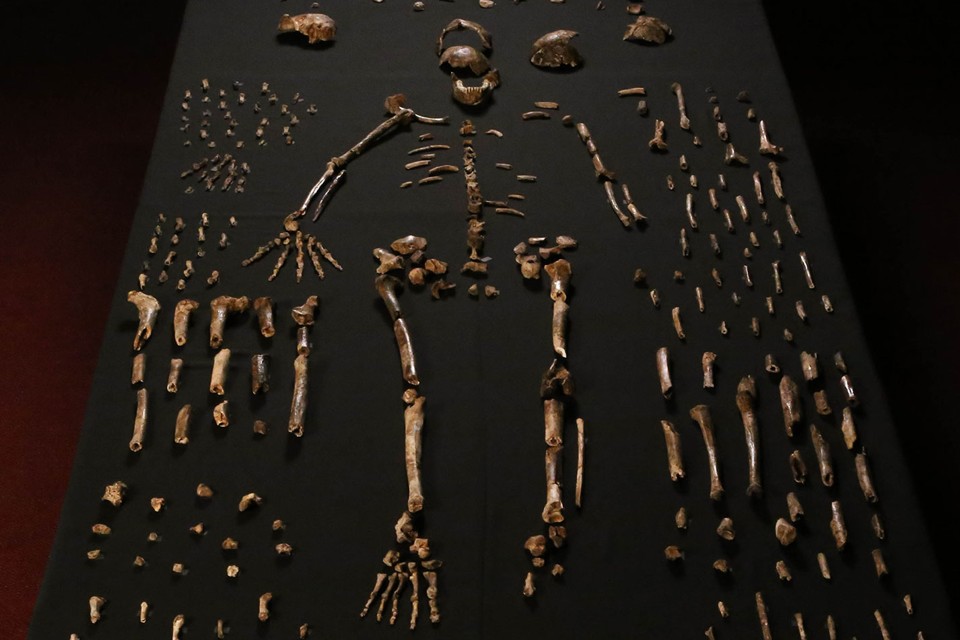The Ed's Up #100
 6 Tiny Cavers, 15 Odd Skeletons, and 1 Amazing New Species of Ancient Human
6 Tiny Cavers, 15 Odd Skeletons, and 1 Amazing New Species of Ancient Human
"That 18-cm gap was all that separated them from the bones of a new species of ancient human, or hominin, which the team named Homo naledi after a local word for “star.” We don’t know when it lived, or how it was related to us. But we do know that it was a creature with a baffling mosaic of features, some of which were remarkably similar to modern humans, and others of which were more ape-like in character. This we know because the six women who entered the cave excavated one of the richest collections of hominin fossils ever discovered—some 1,550 fossil fragments, belonging to at least 15 individual skeletons. To find one complete skeleton of a new hominin would be hitting the paleoanthropological jackpot. To find 15, and perhaps more, is like nuking the jackpot from orbit." (Image: John Hawks)
Bonus: Here's me talking about Homo naledi, on NPR's To the Point.
 A Visit to Amsterdam’s Microbe Museum
A Visit to Amsterdam’s Microbe Museum
On a warm summer afternoon in Amsterdam, a line of visitors snaked toward the entrance of the Artis Royal Zoo, queuing to see the typical assortment of elephants, giraffes, penguins, lions, and so on. I, however, was more interested in the building opposite the ticket booths, which had a very different menagerie inside. A large banner draped over the building’s two stories displayed a collection of fuzzy colored balls, shaped like a waving person. This towering gestalt figure represented the human microbiome—the trillions of bacteria and other microörganisms that inhabit our bodies. With its purposeful stride and genial wave, it welcomed passersby into Micropia, the world’s first museum devoted entirely to microbes.
 Want to Census a Jungle? Sequence DNA From Blood-Sucking Leeches
Want to Census a Jungle? Sequence DNA From Blood-Sucking Leeches
When Thomas Gilbert found the Annamite striped rabbit, he wasn’t traipsing through the jungles of Vietnam where the exceedingly rare creature lives. He wasn’t inspecting a trap, or peering through binoculars. He wasn’t even flicking through photographs captured by a camera-trap. He was, instead, looking at the rabbit’s DNA. Which he had pulled out of a leech. (Image: Dick Culbert)
How Data-Wranglers Are Building the Great Library of Genetic Variation
"When Macarthur launched his lab in 2012, he started by sequencing the exomes of some 300 patients with rare muscle diseases. But he quickly realized that he had nothing decent to compare them against. It has never been easier, cheaper, or quicker to sequence a person’s genome, but interpreting those sequences is tricky, absent a comprehensive reference library of human genetic variation. No such library existed, or at least nothing big or diverse enough. So, MacArthur started making one." (Image: Lollyknit) Sweeping Psychology’s Problems Under the Rug
Sweeping Psychology’s Problems Under the Rug
Recently, I reported that a large team of scientists had tried to replicate the results of 100 psychological experiments—and failed in most cases. Five days later, Lisa Feldman Barrett, a professor of psychology at Northeastern University, took to the New York Times to defend her field. In an op-ed, she argued that “contrary to the implication of the Reproducibility Project, there is no replication crisis in psychology,” and that so-called ‘failures’ to replicate a study are “a normal part of how science works.” (Image: Rigel)
Foetal Cells Hide Out in Mum’s Body, But What Do They Do?
A mother’s children will remain part of her long after they leave her body and enter the world. This isn’t just a saying or a metaphor; it’s biological reality. Every foetus sends some of its own cells into its mother. They cross the placenta, travel through her bloodstream, and lodge in various tissues: brain, thyroid, breast, and more. And then, they stay there. Even after the baby is born, takes its first steps, learns to speak, goes to school, gets a job, and perhaps even becomes a parent itself, some of its cells linger on in its mother. (Image: Amy Boddy)
More good reads
- Who Decides What Makes a Poem Great? Megan Garber on an interesting debate over ethnicity and "best".
- Behold the mighty sage grouse: dances flamboyantly, annoys Republicans, flies at 60mph, shags robots.
- No, there's no evidence that you can catch Alzheimer's. A good corrective from Kelly Oakes
- The $12mm Longitude Prize for whomever dreams up a novel, portable drug-resistance detection device: will it be enough to deal with antibiotic resistance? By Maryn McKenna
- An ode to tardigrades, by Cornelia Dean
More good links will be released in tomorrow's linkfest on Not Exactly Rocket Science.
You can also follow me on Twitter, find regular writing on my blog. If someone has forwarded this email to you, you can sign up yourself.
And that's it! Thanks for reading.
-Ed

